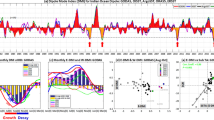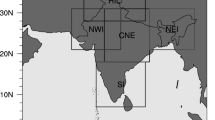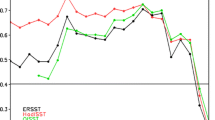Abstract
Interannual variations of the monsoon onset over Kerala (MOK) have been studied using data from over 60 years (1948–2009) of NCEP/NCAR reanalysis and outgoing long-wave radiation. The sea surface temperature fields over the North Indian Ocean associated with the MOK have been examined in association with El Nino and Indian Ocean Dipole (IOD) events which originate in the Pacific and Indian Ocean, respectively. An analysis of the tropical convective maximum showed significant differences in its strength and location during the El Nino, IOD, early, normal, and delayed MOK composites. Further, we also looked into the role of the convective systems formed over the Arabian Sea and Bay of Bengal on MOK. The most significant features during early (delayed) MOK years is the abnormal persistence of westerlies (easterlies) several days prior to MOK and enhanced (suppressed) deep convection over the southeastern Arabian Sea and the southern Bay of Bengal. Moisture builds up over peninsular India several pentads prior to MOK during La Nina, negative IOD, and concurrent La Nina and negative IOD years as compared to the El Nino, positive IOD, and concurrent El Nino and positive IOD years, indicating its significant role on MOK. The monsoon Hadley cell and Walker circulations are weaker (stronger) during a delayed (early) MOK. Further, the sea surface temperature anomalies in the western Pacific are negative (positive) during delayed (early) MOK.













Similar content being viewed by others
References
Allan R, Chambers D, Drosdowsky W, Hendon H, latif M, Nicholls N, Smith I, Stone R, Tourre Y (2001) Is there an Indian Ocean Dipole and is it independent of the El Nino–Southern Oscillation. CLIVAR Exch 6:18–22
Ashok K, Guan Z, Yamagata T (2001) Impact of the Indian Ocean Dipole on the relationship between the Indian monsoon rainfall and ENSO. Geophys Res Lett 28:4499–4502. doi:10.1029/2001GL013294
Ashok K, Guan Z, Saji NH, Yamagata T (2004) Individual and combined influences of ENSO and the Indian Ocean Dipole on the Indian summer monsoon. J Clim 17:3141–3155
Annamalai H, Liu P, **e S-P (2005) Southwest Indian Ocean SST variability: its local effect and remote influence on Asian monsoons. J Clim 18:4150–4167
Ananthakrishnan R, Soman MK (1988) The onset of the southwest monsoon over Kerala 1901–1980. J Climatol 8:283–296
Ananthakrishnan R, Srinivasan V, Ramakrishna AR, Jambunathan R (1968) Synoptic features associated with onset of southwest monsoon over Kerala. IMD, Forecasting Manual, Rep. IV-18.2
Andersson A, Bakan S, Fennig K, Grassl H, Klepp, Christian-Phillip, Schulz J (2007) Hamburg ocean atmosphere parameters and fluxes from satellite data—HOAPS-3-5-days mean. [doi: 10.1594/WDCC/HOAPS3_PENTAD]
Behera SK, Yamagata T (2001) Subtropical SST dipole events in the southern Indian Ocean. Geophys Res Lett 28:327–330
Behera SK, Krishnan R, Yamagata T (1999) Unusual ocean-atmosphere conditions in the tropical Indian Ocean during 1994. Geophys Res Lett 26:3001–3004
Joseph PV (1990) Monsoon variability in relation to equatorial trough activity over Indian and Western Pacific Oceans. Mausam 41(2):291–296
Joseph PV, Eishcheid JK, Pyle RJ (1994) Inter-annual variability of the onset of the Indian summer monsoon and its association with atmospheric features, El Nino, and sea surface temperature anomalies. J Climate 7:81–105
Joseph PV, Sooraj KP, Rajan CK (2003) Conditions leading to monsoon over Kerala and associated Hadley cell. Mausam 54(1):155–164
Joseph PV, Sooraj KP, Rajan CK (2006) The summer monsoon onset process over South Asia and an objective method for the date of monsoon onset over Kerala. Int J Climatol 26:1871–1893
Ju H, Slingo J (1995) The Asian summer monsoon and ENSO. Q J R Meteorol Soc 121:1133–1168
Kalnay EM, Kanamitsu M, Kistler R, Collins W, Deaven D, Gandin L, Iredell M, Saha S, White G, Woollen J, Zhu Y, Leetma A, Reynolds R, Chelliah M, Ebisuzaki, Higgins W, Janowiak J, Mo KC, Ropelewski C, Wang J, Jenne R, Joseph D (1996) The NCEP/NCAR 40 year reanalysis project. Bull Amer Met Soc 77:437–471
Krishnamurthy V, Kirtman BP (2003) Variability of the Indian Ocean: relation to monsoon and ENSO. Q J R Meteorol Soc 129:1623–1646
Liebmann B, Smith CA (1996) Description of a complete (interpolated) outgoing long-wave radiation dataset. Bull Amer Met Soc 77:1275–1277
Meehl GA (1987) The annual cycle and interannual variability in the tropical Pacific and Indian Ocean region. Mon Weather Rev 115:27–50
Meehl GA (1997) The south Asian monsoon and the tropospheric biennial oscillation. J Clim 10:1921–1943
Meehl GA, Arblaster JM (2002) The tropospheric biennial oscillation and Asian–Australian monsoon rainfall. J Clim 15:722–744
Meyers G, McIntosh P, Pigot L, Pook M (2007) The years of El Nino, La Nina and interactions with tropical Indian Ocean. J Climate 20:2872–2880
Nicholls N (1989) Sea surface temperatures and Australian winter rainfall. J Clim 2:965–973
Pearce RP, Mohanty UC (1984) Onsets of the summer monsoon 1979–1982. J Atmos Sci 41:620–1639
Ramesh Kumar MR, Schluessel P (1998) Air sea interaction over the Indian Ocean during the two contrasting monsoon years 1987 and 1988 studied with satellite data. Theor Appl Climatol 60:219–231
Rao SA, Behera SK, Masumoto Y, Yamagata T (2002) Interannual variability in the subsurface tropical Indian Ocean. Deep Sea Res, Part II 49:1549–1572
Rao YP (1976) Southwest monsoons. Meteor. Monogr. No.1, Indian Meteorological Department, pp 1–367
Reason CJC (1998) Warm and cold events in the southeast Atlantic/southwest Indian Ocean region and potential impacts on circulation and rainfall over southern Africa. Meteorol Atmos Phys 69:49–65
Reason CJC, Allan RJ, Lindesay JA, Ansell TJ (2000) ENSO and climatic signals across the Indian Ocean basin in the global context: part I, interannual composite patterns. Int J Climatol 20:1285–1327
Reason CJC (2001) Subtropical Indian Ocean SST dipole events and southern African rainfall. Geophys Res Lett 28:2225–2227
Reason CJC (2002) Sensitivity of the southern African circulation to dipole sea-surface temperature patterns in the south Indian Ocean. Int J Climatol 22:377–393
Saji NH, Yamagata T (2003) Possible impacts of Indian Ocean dipole mode events on global climate. Clim Res 25:151–169
Saji NH, Goswami BN, Vinayachandran PN, Yamagata T (1999) A dipole mode in the tropical Indian Ocean. Nature 401:360–363
Schott FA, **e S-P, McCreary JP (2009) Indian Ocean circulation and climate variability. Rev Geophys 47:RG1002/ 2009, Paper number 2007RG0002
Seetharamayya P, Master (1984) Observed air–sea interface conditions and a monsoon depression during MONEX-79. Arch Meteor Geophy Biokl A33:61–67
Simon B, Rahman SH, Joshi PC (2006) Conditions leading to the onset of the Indian monsoon: a satellite perspective. Meteorol Atmos Phys. doi:10.1007/s00703-005-0155-6
Smith TM, Reynolds RW (2004) Improved extended reconstruction of SST (1854–1997). J Clim 17:2466–2477
Soman MK, Slingo J (1997) Sensitivity of the Asian summer monsoon to aspects of sea surface temperature anomalies in the tropical Pacific Ocean. Q J R Meteorol Soc 123:309–336
Terray P, Delecluse P, Labattu S, Terray L (2003) Sea surface temperature associations with the late Indian summer monsoon. Clim Dyn 21:593–618
Terray P, Dominiak S, Delecluse P (2005) Role of the southern Indian Ocean in the transitions of the monsoon–ENSO system during recent decades. Clim Dyn 24:169–195
Weare BC (1979) A statistical study of the relationships between ocean surface temperatures and the Indian monsoon. J Atmos Sci 36:2279–2291
Webster PJ, Moore AM, Loschnigg JP, Leben RR (1999) Coupled Ocean–atmosphere dynamics in the Indian Ocean during 1997-98. Nature 401:356–360
**e S-P, Annamalai H, Schott FA, McCreary JP (2002) Structure and mechanism of south Indian Ocean climate variability. J Clim 15:864–878
Yuan Y, Li ChongYin (2008) Decadal variability of the IOD ENSO relationship. Chinese Science Bulletin 53:1745–1752
Zhu YL, Houghton DD (1996) The impact of Indian Ocean SST on the large-scale Asian summer monsoon and the hydrological cycle. Int J Climatol 16:617–632
Acknowledgements
The authors are grateful to the various agencies for providing the different datasets used in the present study. Freeware Ferret and GMT were used for preparing the figures. They are also thankful to the two anonymous reviewers for vastly improving an earlier version of the manuscript. Syam Sankar acknowledges financial support from the Council of Scientific and Industrial Research, New Delhi. This is NIO (C.S.I.R) contribution number 4779.
Author information
Authors and Affiliations
Corresponding author
Rights and permissions
About this article
Cite this article
Sankar, S., Kumar, M.R.R. & Reason, C. On the relative roles of El Nino and Indian Ocean Dipole events on the Monsoon Onset over Kerala. Theor Appl Climatol 103, 359–374 (2011). https://doi.org/10.1007/s00704-010-0306-7
Received:
Accepted:
Published:
Issue Date:
DOI: https://doi.org/10.1007/s00704-010-0306-7




